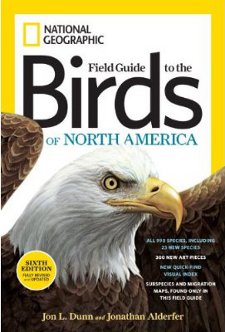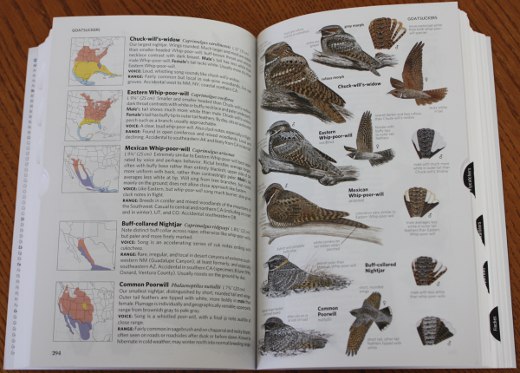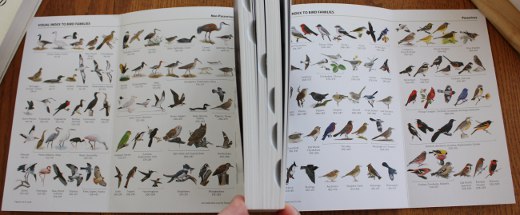Reviewed by Grant McCreary on December 29th, 2011.
I can’t believe it’s been five years since the publication of the fifth edition of the National Geographic Field Guide to the Birds of North America! But it has, which apparently means it is time for the sixth edition. This venerable guide, first published in 1983, has long been considered one of this continent’s best field guides. Does this latest one continue that trend, or is it a superfluous update?
This review will start with an overview of the guide, its structure, and features. In this regard, it does not differ greatly from its predecessors. So if you’re already familiar with this guide’s previous incarnations, you may want to first check out this list of changes from the 5th edition, and then skim ahead to the evaluation.
Plates
The NatGeo guide follows the now-usual plan of illustrations on the right-hand page, with text and range map on the facing page. The plates consist of paintings from 21(!) artists. With that many contributors, you expect a mishmash of styles. That is the case here, both between pages and even within the same plate. Thankfully, most plates, despite the varying styles, are of very high quality. Many of the illustrations are updated or completely redone with each new edition, and those redone for this sixth edition are a clear improvement. Most of the problematic plates from before are now among the best in the guide (i.e. the Spizella sparrows). There are still some plates that need work (like the vireos), but I suppose they have to leave something for the inevitable seventh edition!
A good amount of variation within species is illustrated, including sex, age, seasonal, and regional differences, as appropriate. Each is clearly labeled, including subspecies names, which is very welcome. Additionally, the illustrations are annotated with field marks, a la the Sibley and Collins guides. I love this feature, as it clearly draws attention to the most important characteristics to look for on a bird, and is a great use of space.
Species Accounts
- Name – English and scientific
- Size – length for all species and wingspan for some; in inches and centimeters
- Notes – identification information, including plumage descriptions and behavior
- Voice – description of song and calls
- Range – habitat, abundance, and other information that can’t be shown on a map
The identification information is extensive, but not exhaustive, as the authors focus on the most important characteristics. The descriptions are largely the same as in the prior edition, but the voice and range sections have, on average, been expanded. Many non-passerines, such as shorebirds and gulls, have a voice description for the first time.
Range Maps
All but a few introduced or rarely occurring birds have a range map, including many that did not in the fifth edition. They are large (for a field guide) and zoomed in appropriately for limited ranges. Many also continue well south into Mexico, Central America, and the Caribbean, showing much more of the bird’s entire range than most other field guides. Distinct colors illustrate permanent, breeding, winter, and migration ranges, with dotted lines showing the extent of irregular occurrence. All of this is good, but it is two features unique among current North American field guides that make these maps stand out: distinct colors for spring, fall, and both-way migration, and subspecies names and boundaries.
The extra detail on migration is very helpful, but it is the subspecies information that excites me the most. The maps of 59 birds with multiple subspecies are marked to show the ranges of the constituent subspecies. And if this weren’t enough, there is a separate section in the back of the book with larger and even more detailed maps for 37 additional species.
In most cases, if I were to say that the range maps are the best thing about a field guide, it would be a sign that I was struggling to find something good to say about it. Well, I have no shortage of good things to say about this edition of the National Geographic guide, and the range maps just may be the best thing about it. In fact, it may be worth buying for the maps alone!
Other Features
National Geographic includes all the birds that have been recorded in North America north of Mexico – 990 in all. 92 of these are found in an illustrated list of accidental and extinct species at the end of the book. Along with a single illustration, details of the species’ occurrence and a brief description of appearance is included.
An eight-page introduction describes the plan of the book, gives some tips for better birding, and presents diagrams illustrating the parts of a bird, among other things.
The navigation options have been expanded and improved. The seven thumbtabs for major families have been retained from the previous volume. A “quick find index” on the inside-front cover flap lists birds’ “last name” in alphabetical order. Additionally, a visual index to bird families is printed on the inside of the front and back covers.
Issues
The only issue I have with this guide is not specific to this particular guide, but rather with field guides as a whole – slavery to taxonomic order. Most North American field guides follow the species order prescribed by the American Ornithologists’ Union (AOU) rather closely, at least to the level of family and genus. NatGeo6 is no exception, incorporating the latest changes from the AOU at the time of publication. Most of these changes are to a species’ scientific name, which of course should be kept up-to-date in field guides. But some groups have been moved around. If you want to check out a longspur, for example, you would no longer look after the sparrows (their usual place in field guides since before I’ve been birding), but before the warblers. How does this help birders, especially new ones? More and more, I think field guides should stick to a standard sequence designed to help birders identify birds.
But this review is not the place for such a discussion. And if this is my main issue, that can only be a good thing!
Changes
The sixth edition of the National Geographic guide is not a mere cosmetic change. Dunne and Alderfer have done much more than incorporate the latest AOU updates, add a new species or two, and slightly change the cover. Again, here is a detailed list of changes. This guide is clearly an improvement over the previous edition, even more so than the fifth was better than the fourth.
Recommendation
National Geographic Field Guide to the Birds of North America, Sixth Edition is a great guide. In my review of the fifth edition I qualified my recommendation, especially for owners of a prior edition. Not so with the sixth – it belongs in every birder’s library! From beginner to expert, it will be useful to any birder. And for those interested in geographic variation, it is a must.
Disclosure: I get a small commission for purchases made through links in this post.
Disclosure: The item reviewed here was a complementary review copy provided by the publisher. But the opinion expressed here is my own, it has not been influenced in any way.








Grant,
I could not agree more with your review. I also deplore these often slavic changes in sequence that not only don’t help in the field, but more often even complicate the matter.
I’d actually prefer a slightly smaller book that would be possible without the no longer helpful thumbtabs. Those thumbtabs may be of some help for those who know the new sequence already. But for most, that Quick-Find-Index is the way to go.
Robert
Thanks, Robert.
I use the thumbtabs because they’re there, but could easily get by without them. I imagine it’s the same for most birders who’ve used relatively recent field guides for a little while. The extra size they require doesn’t seem important, but it is a very big deal if that means it no longer fits in your pocket! The thumbtabs are probably the most subjective feature of the guide – how you feel about them will likely be determined by how you use the guide.
Hi!
I’m from France, I’m very passionate by ornithology and I bought this guide because I wanna going to Central Park , NYC ! I hope that this guide will bring to me great informations about the magnificent species of North America ! Here in France , we have absolutely wonderful birding bearings , and across the world , this incredibly passion should be shared through essentials and awesome field-guides such this one !
Redouane, I absolutely agree. This field guide should be very useful to you, and I hope you have a wonderful time birding here!
Thanks Grant !
Plus , North America has a lot of Bio-climatic zones , many birds are coming fom both and tropical zones mostly during their migration steps , It would very fun !
Thanks Grant !
Plus , North America has a lot of Bio-climatic zones , many birds are coming from both Boreal and Tropical zones mostly during their migration steps , it’s awesome !
I have a post talk about National Geographic would like to share with you.
http://www.hiswebhk.com/2012/01/national-geographic-magazine/
Do you have any experience with the regional NG field guides? I’m wondering how the NG eastern guide (2008) compares to this continental 6th ed. (2011)
Thanks!
Phillip: I don’t have the regional NG guides, though I’ve looked through them. I believe the art is entirely based on the older 5th edition. And they won’t have the newer features, like the subspecies range maps. The one exception is the annotated arrows, the regional guides were the first NatGeo’s to include those.
They are a little bit smaller, which could make a difference if carrying it into the field. But unless you think that’s the case, I’d go for the newer continent-wide version.